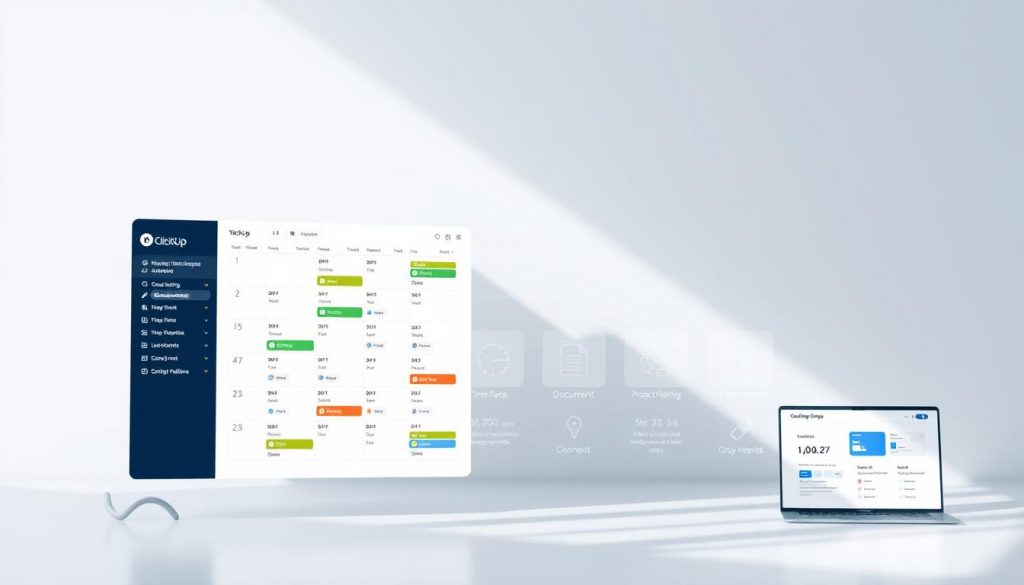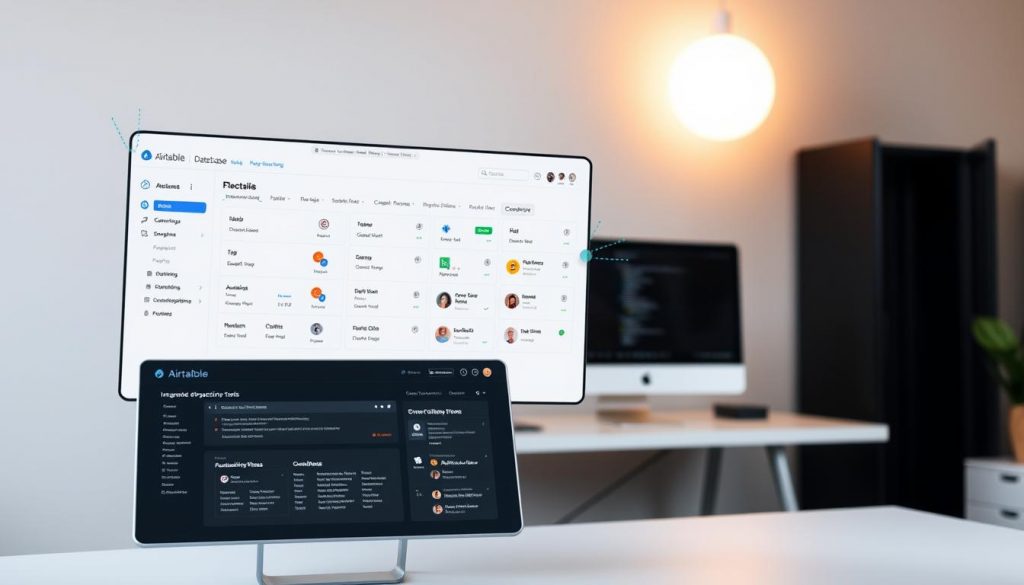In today’s fast-paced work world, productivity software is key for both businesses and individuals. With so many choices, picking the right productivity tools can be tough.
The right productivity software can make workflows better, tasks easier, and productivity higher. As we head into 2025, it’s important to know the best productivity tools.
Pricing for productivity software varies a lot. Knowing these differences helps you make a smart choice. In this article, we’ll look at the top 10 productivity software for 2025. We’ll cover their prices and main features.
Key Takeaways
- Discover the top 10 productivity software for 2025.
- Compare pricing plans across different productivity tools.
- Learn how to choose the best productivity software for your needs.
- Understand the key features of each productivity software.
- Enhance your workflows and boost productivity with the right tools.
The Evolution of Productivity Software in 2025
Productivity software in 2025 will have better AI and easier workflows. It’s now key in work places, changing how we work together and manage tasks.
Productivity software has changed how we manage tasks and work together. It uses AI and automation to make tasks more efficient. This lets users focus on important tasks.
How Productivity Tools Have Transformed Workflows
Productivity tools have made workflows better by automating tasks and improving team communication. They help companies work better and save money.
Businesses can now handle big projects better, track progress, and make smart decisions. Productivity software also helps employees balance work and life, allowing them to work from anywhere.
AI and Automation in Modern Productivity Software
AI and automation are now big parts of productivity software. They help automate tasks and give insights from data. AI tools make software smarter, helping with forecasting, suggestions, and task management.
As productivity software gets better, we’ll see even more AI features. These will change how we work even more. By using these new tools, companies can stay productive and ahead.
Top 10 Productivity Software for 2025: What to Look For
To boost productivity in 2025, knowing what to look for in productivity software is key. When checking out the top 10 productivity software for 2025, several important factors are considered.
Essential Features of Premium Productivity Software
Premium productivity software often has advanced features. These include AI-driven task management, customizable workflows, and enhanced security measures. These features help teams work better and more efficiently.
Some important features to look for are:
- Task automation capabilities
- Real-time collaboration tools
- Advanced reporting and analytics
- Integration with other business applications
Cross-Platform Integration Capabilities
In today’s hybrid work environment, cross-platform integration is key. Productivity software that integrates well with other tools and platforms boosts flexibility and productivity.
Here’s a comparison of cross-platform integration capabilities among popular productivity software:
| Productivity Software | Cross-Platform Integration | Pricing |
|---|---|---|
| Microsoft 365 | Yes | $6.99/user/month |
| Notion | Yes | $4/user/month |
| Asana | Yes | $10.99/user/month |
1. Microsoft 365: The Complete Productivity Software Suite
Microsoft 365 is a top choice for productivity in 2025. It has many tools to help you work better and team up more easily.
Key Features and Capabilities
Microsoft 365 has lots of great features, including:
- Advanced word processing with Microsoft Word
- Powerful spreadsheet analysis with Excel
- Effective presentation design with PowerPoint
- Enhanced collaboration tools with Microsoft Teams
Cloud Integration and Collaboration Tools
Microsoft 365 is known for its cloud integration. This lets you get to your files from anywhere. It also has strong tools for working together, like editing together in real time.
AI-Powered Productivity Enhancements
Microsoft 365 uses AI to make your work better. For example, Excel and PowerPoint offer smart tips to help you work faster.
Pricing Structure and Plans
Microsoft 365 has different plans for everyone:
| Plan | Price | Features |
|---|---|---|
| Personal | $6.99/month | Word, Excel, PowerPoint, Outlook, 1TB OneDrive storage |
| Family | $9.99/month | Same as Personal, for up to 6 users |
| Business | $8.25/user/month | Word, Excel, PowerPoint, Outlook, Microsoft Teams |
Pros and Cons for Different User Types
For personal use, Microsoft 365 has everything you need to stay productive. For businesses, it’s all about teamwork and security. But, some might find the prices hard to understand, and the many features can be too much for beginners.
2. Notion: All-in-One Workspace Productivity Software
Notion is changing how we work by combining many features into one place. It helps teams work better together and get more done.
Versatile Features and Use Cases
Notion has lots of features for different needs. Its flexibility is a big reason people like it.
Database and Knowledge Management
Notion is great for managing databases and knowledge. It lets users create custom databases, making it very useful.
Customizable Workspace Templates
It comes with customizable templates. This makes it easy for teams to start and make the workspace their own.
Pricing Tiers and Value Analysis
Notion has different pricing options, including a free version. This makes it affordable for everyone. It’s important to see what each tier offers.
| Pricing Tier | Features | Value |
|---|---|---|
| Free | Limited features, suitable for small projects | Ideal for individuals or small teams |
| Personal | Additional features, unlimited pages | Best for personal productivity software needs |
| Team | Collaboration features, advanced permissions | Excellent for team collaboration as productivity software |
Strengths and Limitations for Teams
Notion is a strong tool for teams. But, like any software, it has its good and bad points. Teams should think about these when choosing if Notion is right for them.
3. Asana: Project Management Productivity Software
Asana is a top choice for project management. It has tools that help teams stay organized and on track.
Task Management and Workflow Features
Asana is great for managing tasks. Teams can easily create, assign, and track tasks. It also automates repetitive tasks, saving time and boosting productivity.
Timeline and Kanban Capabilities
Asana’s timeline view makes planning projects easy. It shows schedules clearly. Kanban boards are flexible for tracking work, using cards and columns.
Reporting and Analytics Tools
Asana’s reporting tools give teams insights into their work. They can track progress and find ways to improve. Custom reports help in making informed decisions.
Subscription Options and Pricing
Asana has plans for all team sizes and needs. There’s a free basic plan and premium and enterprise options. Teams can pick the best plan for their budget and needs.
Advantages and Disadvantages for Project Teams
Asana’s benefits include its easy-to-use interface and strong features. But, some teams might find it too complex. The cost can also be a factor for smaller teams.
4. ClickUp: Unified Productivity Software Platform
ClickUp is a top choice in productivity software. It combines many tools to help teams work better. It’s perfect for teams wanting to improve their productivity.
Comprehensive Feature Set
ClickUp has a lot of features. It includes tools for managing tasks, creating documents, and setting goals. These are key parts of any good productivity software.
Goals and Sprint Planning Tools
ClickUp helps teams set and reach goals with its sprint planning tools. This is a big part of being productive. It lets teams focus on what’s important and track their progress.
Document and Mind Map Creation
ClickUp also lets you make documents and mind maps. This makes it a great tool for brainstorming and organizing ideas. It’s very useful for teams.

Pricing Plans and Enterprise Options
ClickUp has different pricing plans, including ones for big companies. This means it can fit any team’s budget. It’s a flexible and valuable productivity software.
Benefits and Limitations for Organizations
ClickUp has many benefits, like better teamwork and task management. But, it might be hard to learn at first. Despite this, it’s a great choice for teams looking for a powerful productivity tool.
5. Monday.com: Visual Workflow Productivity Software
Monday.com is changing how teams work with its visual software. It shows tasks clearly, helping teams work better and faster.
Intuitive Interface and Core Features
Monday.com’s design is easy to use. It has features like customizable boards and automations.
Customizable Boards and Automations
Users can make boards that fit their needs. Automations help teams do less manual work, making them more productive.
Integration Ecosystem
Monday.com works well with many apps and services. This makes it easy to connect with other tools teams use.
Pricing Structure and Team Scaling
Monday.com has plans for different team sizes. Prices adjust as teams grow, giving flexibility.
- Basic plan: Starting at $8 per user per month (billed annually)
- Standard plan: Starting at $10 per user per month (billed annually)
- Premium plan: Starting at $16 per user per month (billed annually)
- Enterprise plan: Custom pricing for large organizations
Strengths and Weaknesses for Different Industries
Monday.com works for many industries. It’s flexible and customizable. But, it might take some time to learn for new users.
“Monday.com has transformed the way our team collaborates and manages projects. The visual interface is incredibly intuitive, and the automation features have saved us a significant amount of time.”
Monday.com is a great tool for teams wanting to improve their work flow and productivity.
6. Trello: Kanban-Based Productivity Software
Trello is a favorite among teams looking for productivity software. It’s known for its easy-to-use interface and Kanban-based task management. This makes it simple to organize and prioritize tasks.
Board and Card System Features
The heart of Trello is its board and card system. Boards are for projects, and cards are for tasks. This setup helps teams keep their work organized and focused.
Trello gets even better with Power-Ups. These add-ons bring in features from other apps, like calendar views and automation.
Automation Capabilities
Trello’s automation helps teams save time. It automates tasks, making it easier to manage multiple projects. This is a big plus for teams with a lot on their plates.
Free and Premium Pricing Options
Trello has both free and paid plans. The free version is great for small teams, with basic features. The paid plans offer more, like advanced checklists and support.
Advantages and Limitations for Small Teams
Small teams love Trello for its flexibility and growth. But, as teams get bigger, they might need more advanced tools. Trello might not have everything they need.
| Plan | Features | Price |
|---|---|---|
| Free | Basic features, unlimited boards and cards | $0 |
| Premium | Advanced checklists, priority support | $12.50/user/month |
| Enterprise | Additional security features, dedicated support | Custom pricing |
7. Evernote: Note-Taking Productivity Software
Evernote is a top tool for note-taking. It has many features for both personal and work use. It’s a key tool for anyone who needs to organize information.
Note Organization and Search Features
Evernote is great at organizing notes. It has strong search tools and a system for keeping notes tidy. You can use tags, notebooks, and stacks to sort and find your notes easily.
Web Clipper and Content Capture
The Web Clipper lets you save web pages and articles into Evernote. This makes it easier to keep track of your research and references.
Cross-Device Synchronization
Evernote lets you access your notes on any device. This means you can work on your computer, tablet, or phone without missing a beat.
Personal and Business Pricing Plans
Evernote has different plans for everyone. You can choose from free, Personal, Professional, and Teams plans. Each plan meets different needs, from simple note-taking to complex business tasks.
Pros and Cons for Knowledge Workers
Knowledge workers love Evernote for its search, organization, and device compatibility. But, some might find the pricing and free version limits a drawback. Despite this, Evernote is a favorite for those who need a powerful note-taking tool.
8. Todoist: Task Management Productivity Software
Todoist is a top task management software. It helps users organize their work well. It’s great for both personal and work tasks.
Task Organization and Priority Features
Todoist is great at organizing tasks. It lets users make and manage tasks easily. It also helps sort tasks by urgency and importance.
Natural Language Processing
Todoist has a cool feature: natural language processing. It lets users type tasks like they talk. This makes adding tasks easy and fun.
Goal Tracking and Visualization
Todoist also tracks and shows your progress. This keeps you motivated and on track to meet your goals. It’s a top choice for managing tasks.
Free and Premium Pricing Tiers
Todoist has free and paid options. The free version has basic features. The paid version has more, making it a great choice for many.
Strengths and Limitations for Personal Productivity
Todoist is simple yet powerful. It’s great for personal tasks. But, it might not have as many reporting options as others.
In short, Todoist is a top choice for task management. Its easy-to-use design and cool features help boost productivity.
9. Slack: Communication-Focused Productivity Software
Slack makes team communication easy and boosts productivity. It helps teams work together smoothly, no matter where they are.
Channel-Based Messaging Features
Slack’s messaging system organizes chats into channels. This makes it easy to find what you need and cuts down on email. It’s great for big teams or projects with lots of people involved.
Huddles and Video Conferencing
Slack’s huddles let teams talk or video call anytime. It’s perfect for quick, real-time teamwork and making fast decisions.
App Integration Marketplace
Slack’s app store has lots of third-party apps. These apps add more features and make Slack even more useful for your team.
Free and Paid Plan Structures
Slack has free and paid plans for all team sizes. The free plan has basic features. Paid plans add more storage and security.
Here’s a look at Slack’s pricing:
| Plan | Features | Price |
|---|---|---|
| Free | Basic features, 10,000 message limit | $0 |
| Pro | More features, more storage | $7.25/user/month |
| Business+ | More security, support for rules | $12.50/user/month |
| Enterprise Grid | Top security, support for big teams | Custom pricing |
Benefits and Drawbacks for Remote Teams
Slack is great for remote teams. It improves communication, teamwork, and productivity. But, it can be too much for some, and the cost can be high for big teams.
“Slack has been a game-changer for our remote team. It’s helped us stay connected and organized, even when we’re working from different time zones.”
10. Airtable: Database Productivity Software
Airtable is a top database tool that mixes simplicity with power. It’s a key productivity software for teams and companies.
Flexible Database and Spreadsheet Features
Airtable combines a spreadsheet’s flexibility with a database’s strength. It’s a strong productivity software for managing data.
Views and Visualization Options
Airtable has views like grid, calendar, and Kanban. These help users see their data in the best way. It’s great for managing projects and tracking.
Automation and API Capabilities
Airtable’s automation makes tasks easier. Its API lets users connect with other productivity software. This boosts workflow efficiency.
Pricing Plans and Enterprise Solutions
Airtable has plans for all, from free to enterprise. It fits teams of all sizes and needs. This makes it a flexible productivity software choice.
| Pricing Plan | Features | Price |
|---|---|---|
| Free | Basic database features, up to 5 users | $0 |
| Premium | Advanced features, up to 100 users | $12/user/month |
| Enterprise | Custom features, unlimited users | Custom Pricing |
Advantages and Limitations for Data Management
Airtable is great for managing data, thanks to its database productivity features. It’s flexible and scalable. But, it might struggle with very complex data.
Overall, Airtable is a strong productivity software for data management. It’s a valuable tool for teams and organizations.

Comprehensive Pricing Comparison of Productivity Software
In 2025, knowing the prices of top productivity software is key. There are many choices, so it’s important to compare costs and features. This helps find the right tool for your needs and budget.
Pricing Table for All Products
The table below shows the prices for the top productivity software:
| Software | Free Plan | Basic Plan | Premium Plan | Enterprise Plan |
|---|---|---|---|---|
| Microsoft 365 | No | $6/user/month | $12/user/month | Custom Pricing |
| Notion | Yes | $4/user/month | $8/user/month | $15/user/month |
| Asana | Yes | $9.99/user/month | $19.99/user/month | Custom Pricing |
Best Value Productivity Software for Different Budgets
Budget is a big factor when picking productivity software. For small businesses, Trello and Todoist are good choices. They have free and basic plans.
Larger enterprises might prefer Microsoft 365 and Airtable. They offer full solutions with prices tailored to big businesses.
For individuals, Evernote and Notion are great. They have flexible pricing that meets both personal and work needs.
Conclusion
The top 10 productivity software for 2025 are designed to make our work easier and more efficient. They range from all-in-one suites like Microsoft 365 to specialized tools like Trello and Asana. Each one has its own strengths and ways to help us work better.
Comparing these software tools shows how they can really improve how we work. They automate tasks, help us work together, and give us insights into our projects. This means teams can reach their goals faster and more effectively.
When picking a productivity software, look at things like how well it works on different devices, its user interface, and the cost. The top 10 for 2025 have shown they can really help improve our workflows. They are great for both businesses and individuals.
Using the right productivity software can make a big difference. It can help us work better, save money, and stay ahead of the competition. Keeping up with the latest in productivity software is key to getting the most out of it.
In the end, the right productivity software can change how we work. It lets us do more in less time. By choosing the right tool for our needs, we can reach our full success.


